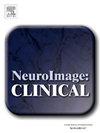Structural connectome manifold changes related to body mass index and their associations with eating psychopathology
IF 3.6
2区 医学
Q2 NEUROIMAGING
引用次数: 0
Abstract
Brain connectome analysis provides insights into body mass index (BMI)-related brain topology and cognitive functions. While alterations in the brain connectome have been observed in individuals with high BMI, evidence regarding BMI-based structural connectome alteration remains limited. In this study, we analyzed diffusion magnetic resonance imaging tractography-derived structural connectivity from 283 neurologically healthy participants by generating low-dimensional features using dimensionality reduction techniques. Two key metrics were calculated: manifold eccentricity, which indicates the relative distance of each brain region from the center of the low-dimensional manifold space, and manifold differentiation, which represents the distance between brain regions within the manifold space. Our findings revealed that individuals with high BMI exhibited greater expansion and differentiation in the control, default mode, and somatomotor networks, reflecting increased network segregation. In contrast, the visual and limbic networks displayed higher integration. Furthermore, network communication measures based on search information and path transitivity indicated less efficient communication between low-level sensory and higher-order transmodal networks in individuals with high BMI. Finally, significant associations were identified between the manifold features in the prefrontal and somatomotor regions and eating behaviors, as assessed by self-report measures from the Eating Disorder Examination Questionnaire (EDEQ) and the Three-Factor Eating Questionnaire (TFEQ). These results highlight the critical role of structural connectome organization in describing BMI and eating behaviors.
身体质量指数相关的结构连接体多样性变化及其与饮食精神病理的关系
脑连接组分析提供了对身体质量指数(BMI)相关的大脑拓扑结构和认知功能的见解。虽然在高BMI个体中观察到脑连接组的改变,但关于基于BMI的结构连接组改变的证据仍然有限。在这项研究中,我们通过使用降维技术生成低维特征,分析了283名神经健康参与者的扩散磁共振成像神经束图衍生的结构连通性。计算了两个关键指标:流形偏心率(表示每个脑区与低维流形空间中心的相对距离)和流形分化(表示脑区在流形空间内的距离)。我们的研究结果表明,BMI高的个体在控制、默认模式和躯体运动网络中表现出更大的扩张和分化,反映了网络隔离的增加。相比之下,视觉和边缘网络表现出更高的整合。此外,基于搜索信息和路径传递性的网络通信测量表明,高BMI个体的低阶感觉网络和高阶跨模式网络之间的通信效率较低。最后,通过进食障碍检查问卷(EDEQ)和三因素进食问卷(TFEQ)的自我报告测量,发现前额叶和躯体运动区域的多种特征与进食行为之间存在显著关联。这些结果强调了结构连接体组织在描述BMI和饮食行为方面的关键作用。
本文章由计算机程序翻译,如有差异,请以英文原文为准。
求助全文
约1分钟内获得全文
求助全文
来源期刊

Neuroimage-Clinical
NEUROIMAGING-
CiteScore
7.50
自引率
4.80%
发文量
368
审稿时长
52 days
期刊介绍:
NeuroImage: Clinical, a journal of diseases, disorders and syndromes involving the Nervous System, provides a vehicle for communicating important advances in the study of abnormal structure-function relationships of the human nervous system based on imaging.
The focus of NeuroImage: Clinical is on defining changes to the brain associated with primary neurologic and psychiatric diseases and disorders of the nervous system as well as behavioral syndromes and developmental conditions. The main criterion for judging papers is the extent of scientific advancement in the understanding of the pathophysiologic mechanisms of diseases and disorders, in identification of functional models that link clinical signs and symptoms with brain function and in the creation of image based tools applicable to a broad range of clinical needs including diagnosis, monitoring and tracking of illness, predicting therapeutic response and development of new treatments. Papers dealing with structure and function in animal models will also be considered if they reveal mechanisms that can be readily translated to human conditions.
 求助内容:
求助内容: 应助结果提醒方式:
应助结果提醒方式:


